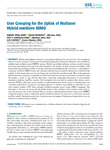User Grouping for the Uplink of Multiuser Hybrid mmWave MIMO

Use this link to cite
http://hdl.handle.net/2183/25361
Except where otherwise noted, this item's license is described as Atribución 4.0 Internacional (CC BY 4.0)
Collections
- Investigación (FIC) [1678]
Metadata
Show full item recordTitle
User Grouping for the Uplink of Multiuser Hybrid mmWave MIMODate
2020-03-16Citation
D. Pérez-Adán, Ó. Fresnedo, J. P. González-Coma and L. Castedo, "User Grouping for the Uplink of Multiuser Hybrid mmWave MIMO," in IEEE Access, vol. 8, pp. 55323-55341, 2020. DOI: 10.1109/ACCESS.2020.2981280
Abstract
[Abstract] Hybrid analog/digital schemes for precoding/combining have proved to be a low-complexity and/or low-power strategy to obtain reasonable beamforming gains in multiuser millimeter-wave (mmWave) multiple-input multiple-output (MIMO) systems. Hybrid precoding/combining performs jointly baseband processing and analog processing in the radio frequency (RF) domain. In these systems, the number of RF chains limits the maximum number of streams simultaneously handled by the transceivers. In the uplink of a multiuser mmWave MIMO system, the hardware reduction based on hybrid transceivers is limited by the number of data streams that must be simultaneously served by the centralized node. Most works approach hybrid transceiver design by considering more RF chains than data streams, an unrealistic assumption when the number of nodes is large. On the other hand, statistically independent information is conventionally assumed in multiuser mmWave systems. This assumption does not hold in scenarios like wireless sensor networks (WSNs), where the sources produce correlated information. In this paper, by enabling inter-user correlation exploitation, we propose a grouping approach to handle a high number of individual sources with a limited number of RF chains through distributed quantizer linear coding (DQLC) mappings. The allocation of the users per group and the hybrid design of the combiner at the common central node to serve the grouped users is also analyzed. We also propose a hybrid minimum mean square error (MMSE) combining design in order to exploit the spatial correlation between the sources in a conventional uncoded mmWave uplink. Simulation results show the performance advantages of the proposed approaches in various hardware-constrained system settings.
Keywords
Radio frequency
Uplink
Correlation
Encoding
Baseband
Massive MIMO
Uplink
Correlation
Encoding
Baseband
Massive MIMO
Editor version
Rights
Atribución 4.0 Internacional (CC BY 4.0)
ISSN
2169-3536






